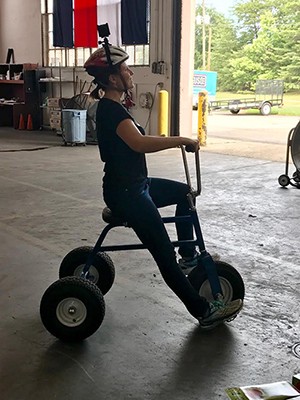BY SANDI MOYNIHAN| FALL 2017
For the past two months, I’ve been working on-and-off shooting a 360 video piece to tell the story of one of the USO’s most popular programs: the care package program. Given the program’s wide geographical footprint, I thought it would be a great opportunity for the USO (and myself!) to dive into the world of immersive video production by taking viewers around the world.
Armed with advice and all the information I could find about shooting 360 video on the Internet, I created a storyboard, purchased a Nikon KeyMission 360 camera, produced a small-scale, practice project and headed into the field to film my first immersive video story. As a professional photographer and videographer, I felt pretty confident. I spent hours interviewing key characters, traveling to different locations and even overseas, which, I’ll admit, felt pretty cool.
That's me, riding an adult tricycle, while shooting 360 video.
I’m by no means an expert in 360 video, but after shooting this entire project, I thought I was doing everything right when it came to immersive video — until I attended Google’s “Shooting a Virtual Reality Video” session at this year’s Adobe Max conference. That’s when I realized I still had a lot to learn.
Are you a creator thinking about embarking on your first 360 project? Here are the top six tips I gained from this session, so you can avoid some pitfalls I experienced:
1. Focus on the Story
Learning how to shoot immersive video can be a frustrating process that takes a lot of time and energy. However, panelist Gary Hustwit of Scenic cautions new immersive storytellers from focusing too much on the technical aspects of their project. Instead, he urges filmmakers to spend most of their energy developing a strong story arc that will capture the audience’s attention, regardless of technical flaws. No 360 camera on the market right now is perfect. They all have stitching, sound, quality and connectivity issues. You cannot control this! What you can control is crafting a strong narrative, capturing in-focus footage and collecting good, crisp audio.
2. Think Like a Theater Director, Not a Videographer
360 video cameras capture everything in a scene, so there’s no hiding anything from the frame like in traditional video storytelling. To help visualize and plan scenes, immersive filmmakers should try to approach their shots like a theater director, considering the audience’s perception of the performance from every seat in the house.
3. The Smaller the Production Team, the Better
When shooting an immersive video project, smaller production teams are much easier to manage, particularly when ensuring crew members aren’t in the backgrounds of shots. Session panelists Ben Ross and Brittany Neff of CoReality say they typically shoot in teams of 2–5 people, with a team of two being preferable because they are the easiest to manage and the smallest size a crew can realistically be to get the job done.
4. Let Your Characters Tell Their Stories
According to Ross and Neff, the most effective immersive videos are narrative-driven and feature a main character who shares their story with the audience by speaking directly into the camera, almost as if they were having a conversation. The intimate nature of immersive video, in Ross and Neff’s practice, allows for this type of interview to work well.
A great example of a narrative-driven feature produced by the team at CoReality.
However, for this approach to be successful, you must work very closely with your characters to make them comfortable in front of the camera. Unlike traditional video, you may not be with your characters to ask them questions, prompt their responses, coach their movements, etc., unless you want to be in the shot, too. So, you must make them feel confident in their actions without your help. Remember, you won’t be able to see what your characters are doing while recording, as many 360 cameras don’t allow for live video monitoring.
5. Don’t Move the Camera Too Much
While some well-executed camera movement can be effective, generally, moving a 360 video camera too much can be very jarring for a viewer. It can also make a headset-wearing viewer motion sick. Instead, challenge yourself to use movement of objects around the camera to create a sensation of motion or create the visual experience you are looking for.
A super informative video about 360 video motion sickness.
6. Editing a 360 Video Isn’t Overwhelmingly Different
Once you get your bearings and get beyond stitching, the basics of creating a 360 video aren’t any different than creating a regular video. You’re still working in a timeline, cutting clips, editing sound, color correcting, etc. However, there are a few immersive video-specific tools, workflows and best practices that might help make your editing process better, including in the 2018 Adobe Creative Cloud.
At the end of the day, the most important thing to remember when you’re putting together your first immersive video piece is that nobody is an expert, according to panelist and filmmaker Hustwit. Even the experts in immersive video have only been working at it for a few years, so don’t worry about making mistakes. We’re all in the same boat.
I hope my lessons learned will help you with your first or next immersive project. If they do, I’d love to know — comment below or tweet me @sandimoynihan.
By the way, my care package video is coming out soon, so keep your eyes peeled for its release in late 2017!


